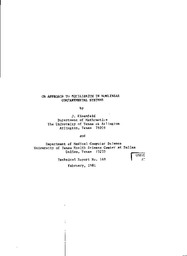
ATTENTION: The works hosted here are being migrated to a new repository that will consolidate resources, improve discoverability, and better show UTA's research impact on the global community. We will update authors as the migration progresses. Please see MavMatrix for more information.
Show simple item record
| dc.contributor.author | Eisenfeld, Jerome | en |
| dc.date.accessioned | 2010-06-09T15:07:21Z | en |
| dc.date.available | 2010-06-09T15:07:21Z | en |
| dc.date.issued | 1981-02 | en |
| dc.identifier.uri | http://hdl.handle.net/10106/2426 | en |
| dc.description.abstract | **Please note that the full text is embargoed** ABSTRACT: A closed compartmental system is a set of nonnegative interdependent functions,
[see pdf for notation]
such that their sum is constant. The functions can represent populations, masses or concentrations, depending on the particular application. It
is convenient to normalize so that
[see pdf for notation]
in which case the functions are proportions. It is assumed that the (nonnegative) flow rate from j to i has the form fjjxj. Thus, the rate of change,
[see pdf for notation]
The first term is the inflow to i from the other "compartments" and the second term is the outflow from i to the other compartments. Setting
[see pdf for notation]
we obtain the system in vector form,
[see pdf for notation]
In classical compartmental analysis [1]-[4], which deals mainly with tracer and drug studies, each xi represents the amount of tracer or drug in an organ or a compartment of the human body, hence the term "compartment". Moreover, in classical work, the fij are treated as constants, however, in more recent work [5]-[12], they are functions,
[see pdf for notation]
Let us consider a classical tracer study. | en |
| dc.language.iso | en_US | en |
| dc.publisher | University of Texas at Arlington | en |
| dc.relation.ispartofseries | Technical Report;149 | en |
| dc.subject | Compartmental analysis | en |
| dc.subject | Closed system | en |
| dc.subject | Compartmental systems | en |
| dc.subject | Classical tracer study | en |
| dc.subject.lcsh | Mathematics Research | en |
| dc.title | On Approach to Equilibrium in Nonlinear Compartmental Systems | en |
| dc.type | Technical Report | en |
| dc.publisher.department | Department of Mathematics | en |
Files in this item
- Name:
- MathTechReport149.pdf
- Size:
- 538.1Kb
- Format:
- PDF
- Description:
- PDF
This item appears in the following Collection(s)
Show simple item record


